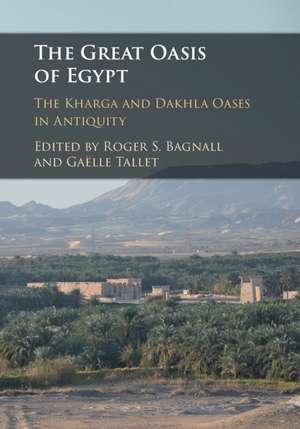The Great Oasis of Egypt: The Kharga and Dakhla Oases in Antiquity
Editat de Roger S. Bagnall, Gaëlle Talleten Limba Engleză Hardback – 17 iul 2019
Preț: 774.93 lei
Preț vechi: 901.09 lei
-14% Nou
Puncte Express: 1162
Preț estimativ în valută:
148.29€ • 153.21$ • 123.36£
148.29€ • 153.21$ • 123.36£
Carte disponibilă
Livrare economică 26 februarie-12 martie
Preluare comenzi: 021 569.72.76
Specificații
ISBN-13: 9781108482165
ISBN-10: 1108482163
Pagini: 362
Ilustrații: 26 b/w illus. 11 maps 6 tables
Dimensiuni: 181 x 252 x 23 mm
Greutate: 0.86 kg
Editura: Cambridge University Press
Colecția Cambridge University Press
Locul publicării:Cambridge, United Kingdom
ISBN-10: 1108482163
Pagini: 362
Ilustrații: 26 b/w illus. 11 maps 6 tables
Dimensiuni: 181 x 252 x 23 mm
Greutate: 0.86 kg
Editura: Cambridge University Press
Colecția Cambridge University Press
Locul publicării:Cambridge, United Kingdom
Cuprins
1. Introduction Roger S. Bagnall and Gaëlle Tallet; Part I. Living in the Oasis: Humans and the Environment: 2. Water resources and irrigation in two oases of the Western Desert of Egypt, Kharga and Dakhla Jean-Paul Bravard; 3. The ancient population of the Kharga Oasis Françoise Dunand and Roger Lichtenberg; 4. Trimithis: a case study of Proto-Byzantine urbanism Paola Davoli; Part II. Managing the Oasis: 5. The Great Oasis: an administrative entity from Pharaonic times to Roman times Roger S. Bagnall and Gaëlle Tallet; 6. Land and resource administration: farmers, managers, and soldiers in the Great Oasis Rodney Ast; 7. What remains in the hands of the Gods: taxation in Kharga Oasis through the Demotic Ostraca (fifth century BC–first century AD) Damien Agut-Labordère; Part III. Trade and Mobility in a Connected Environment: 8. The North Kharga Oasis Darb Ain Amur Survey (NKODAAS): surveying the tracks between the two Oases Salima Ikram; 9. And the potsherds? Some avenues of reflection and synthesis on the pottery of the Great Oasis Pascale Ballet; 10. Egyptian and imported amphorae at Amheida Clementina Caputo; 11. Kegs from Amheida Irene Soto Marin; 12. El-Deir as a switching point Yaël Chevalier; Part IV. An Oasis Culture?: 13. Temple building on the Egyptian margins: the geopolitical issues behind Seti II and Ramesses IX's activity at Amheida Olaf E. Kaper; 14. Funerary practices in the Great Oasis during Antiquity Françoise Dunand and Fleur Letellier-Willemin; 15. Was there an interest in literary culture in the Great Oasis? Some answers Raffaella Cribiore; 16. The House of Serenos and wall painting in the Western Oases Susanna McFadden.
Descriere
Explores the history and archaeology of two oases, remote but closely tied to the Nile valley for thousands of years.
